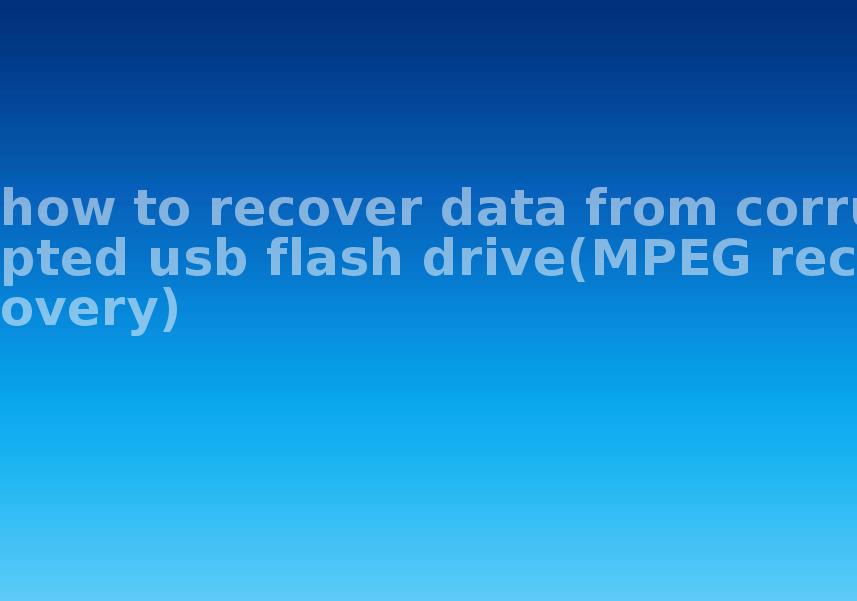how to recover data from corrupted usb flash drive(MPEG recovery)
2023-10-21 03:00 310
Part I: Overview of the context in which the document was recovered
The process of recovering data from a corrupted USB flash drive involves retrieving lost or damaged files from the storage device. A USB flash drive is a portable storage device that is susceptible to various issues, such as physical damage, file system corruption, virus/malware infection, and accidental deletion. When a USB flash drive becomes corrupted, it becomes inaccessible, and data stored on it may appear to be lost.
There are several common scenarios in which data recovery from a corrupted USB flash drive becomes necessary:
1. Physical damage: Dropping or mishandling the USB flash drive can cause physical damage, such as a broken connector, which leads to the corruption of data.
2. File system corruption: Improper removal of the USB flash drive, power surges, or system crashes can lead to file system corruption. As a result, the drive may become unreadable, and data on it may become inaccessible.
3. Virus/malware infection: USB flash drives are prone to virus and malware infections. These infections can corrupt files, render them unreadable, or hide them from view.
Part II: Causes of data corruption in MPEG files and examples

MPEG (Moving Picture Experts Group) is a commonly used format for video and audio files. The corruption of MPEG files can occur due to various reasons, including:
1. Incomplete file transfer: If the transfer of an MPEG file from a USB flash drive is interrupted or incomplete, it can result in corruption of the file.
2. Incorrect file conversion: Converting MPEG files to other formats using unreliable or faulty software can lead to corruption.
3. File system errors: If the file system of the USB flash drive becomes corrupted, it can affect the integrity of MPEG files stored on it.
Part III: Solution for recovering data from a corrupted USB flash drive
To recover data from a corrupted USB flash drive, follow these steps:
1. Disconnect the USB flash drive from the computer and stop using it to prevent further damage. 2. Use reliable data recovery software like Recuva, EaseUS Data Recovery Wizard, or MiniTool Power Data Recovery. 3. Install and run the data recovery software on your computer. 4. Connect the corrupted USB flash drive to the computer. 5. Select the USB flash drive as the target location for data recovery in the software. 6. Start the scanning process to search for recoverable files on the USB flash drive. 7. After the scanning is complete, preview the recovered files and select the ones you want to restore. 8. Choose a new destination folder on your computer to save the recovered files. 9. Initiate the data recovery process and allow the software to restore the selected files. 10. Once the recovery is complete, safely remove the USB flash drive from the computer and store the recovered files in a secure location.

Part IV: Types of other files that can be recovered from a corrupted USB flash drive
Apart from MPEG files, a corrupted USB flash drive can contain various other types of recoverable files, such as:
1. Photos: JPEG, PNG, TIFF, RAW image files, etc. 2. Documents: Word documents, Excel spreadsheets, PowerPoint presentations, PDF files, etc. 3. Audio: MP3, WAV, FLAC, AAC, etc. 4. Videos: AVI, MP4, MKV, MOV, etc. 5. Archive files: ZIP, RAR, 7Z, etc. 6. Emails: Outlook PST files, mailbox files, etc. 7. Databases: SQLite, MySQL, MS Access, etc.
Part V: Related FAQs
Q1: Can I recover data from a physically damaged USB flash drive? A1: In some cases, data can be recovered from physically damaged USB flash drives. However, it may require professional assistance from data recovery services.
Q2: How long does the data recovery process take? A2: The time required for data recovery depends on various factors, including the size of the USB flash drive, the extent of corruption, and the chosen recovery method. It can range from a few minutes to several hours.
Q3: What should I do if the data recovery software cannot recover my files? A3: If the initial data recovery attempt fails, you may consider seeking professional help from a data recovery service. They have specialized tools and expertise to recover data from severely damaged USB flash drives.









